Whatever industry we operate in, no matter the size of our organization; we're all running in the same race. The one to ensure that we’re at the forefront of customer experiences, winning business and operating as efficiently as possible, which is only harder during these times of increasing political and economic uncertainty.
Everyone is gearing up to win this race in the same way, through digital transformation and data. According to our Multi-Cloud Maturity Index, by 2024, 95% of organizations across EMEA will be looking to their data as a revenue driver, with 46% recognizing it as a significant source of revenue – up from 29% today.
Applications define whether you win or lose
The race to drive revenue from data continues to be defined by how quickly, securely and profitably organizations can get new applications, or re-write existing ones, to market in pursuit of their strategic goals. While these applications used to exclusively live in data centers, they have over time moved in the cloud; and over time new clouds have evolved to offer new capabilities.
Multi-cloud as an essential enabler
There are private clouds, hosted entirely on-premises; public clouds, hosted externally by cloud providers; and hybrid clouds, combining the benefits of both. A few years ago, we saw the beginnings of local clouds, residing at the edge at distributed sites. And most recently sovereign clouds, driven by the demands of new data protection legislation. Multi-cloud is now the default in a world where an organization’s most valuable assets – its apps, data, workforce and infrastructure - are no longer centralized in physical buildings but distributed anywhere and everywhere.
A clear path to greater revenue and growth
The value of multi-cloud is well and truly proven. Almost everyone (95%) agrees that multi-cloud architectures are now critical to business success; with 48% believing those who don’t adopt a multi-cloud approach risk failure. Almost half (46%) believe multi-cloud use has had a very positive impact on revenue growth, while 46% also believe it has had a very positive impact on profitability. In fact, only 4% believe multi-cloud is not critical to business success.
Increased complexity and chaos
To see this value, organizations must cut through the increased complexity and chaos that can come with operating multiple clouds, which most companies are. Senior leaders we spoke to say their ambition to realize more value from data this way is being held back by issues with security, skills, difficulty stitching different cloud environments together and siloed access to data. Organisations must also improve the control they have over their operational and cloud expenses, which is a concern if data is to drive genuine business value.
Common roadblocks for all
Each cloud has a different model. Multiple models mean increased complexity and therefore increased risk and cost. Moving apps to the cloud and from cloud to cloud is difficult, time-consuming and costly; as is training and re-training teams to manage apps after a migration, especially with the current skills scarcities in the IT marketplace. All this expensive complexity is crying out to be simplified.
Simplify, secure, scale
Cloud smart companies are choosing to use a single, multi-cloud platform on which they can build, run, manage and secure all applications, consistently, at scale across all clouds. Take the McLaren Racing team as an example. It relies on a range of key applications to enhance vehicle aerodynamics; optimize car components; and make real-time, data-driven racing decisions. By using a hybrid of trackside infrastructure, its own data centers and public cloud environments for running essential apps, McLaren is maximizing the value of multi-cloud to help win races.
Using a smart multi-cloud platform enables companies like McLaren to choose the best environment for specific applications, with all the visibility, efficiency and control required, at less risk and faster time to value.
It also enables them to choose the right environment for the right data, including latency sensitive information that needs to remain close for performance. Something that is of increasing importance with the deadline for DORA hitting next year. And because they’re using the same platform, tools and management across all environments, there’s no need to re-tool, re-train and so on. With belts tightening in response to the downturn expected this year, it’s all too easy to push investment on the back-burner in favor of holding tight. But history has taught us those who continue to invest in smart areas are the most likely to rebound and thrive. Smart multi-cloud enables organizations of all shapes and sizes to deliver positive outcomes for the organization and its stakeholders. Now is not the time to freeze in the chaos, but rather to be smart and win the race.


